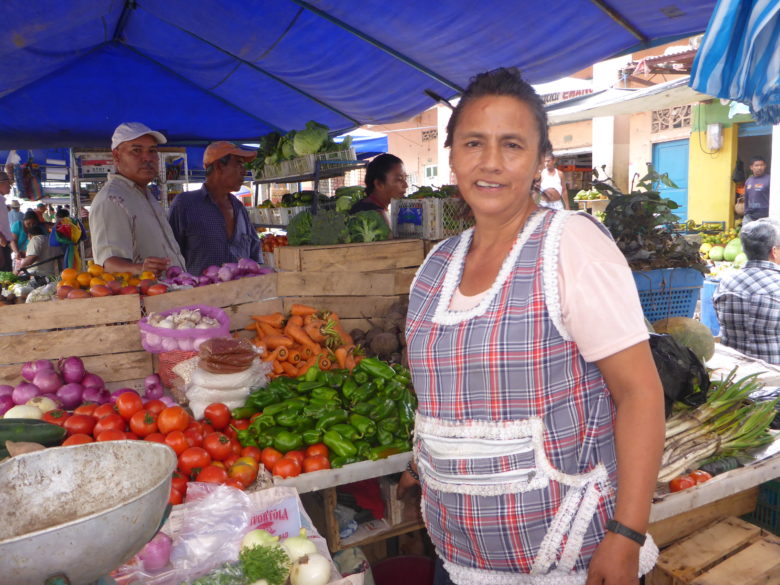Return to Chaos
00:36.38S 80:25.312W Last Days in Bahia.
Our coach bounced along the rice road in a westerly direction from Guayaquil, people sitting at the side of the road beside piles of various sizes of sacked rice tagged with prices written on cards. There was little evidence of the earthquakes here. A film was showing loudly on the TV at the front of the coach, but most people were snoozing or thumbing their phones.
The scenery changed from rice paddy fields to gentle sandstone hills, brown maize crops and broccoli trees (ceibo trees I learned from Tory) and at the junction where we turned right for Bahia, we saw the first broken buildings, a modern hospital still open but in need of medical care itself with cracked walls and broken glass.
Brittle and overly rigid, unforgiving concrete and single skin brick walls seemed to have fared the worst. Metal or concrete fence posts still stood but the section of red brick between them would have a big horseshoe space of missing bricks between the posts and the side walls of houses showed the same pattern.
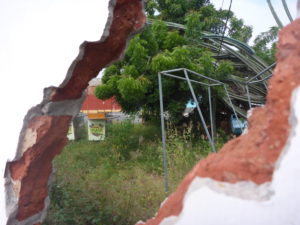
Suddenly the coach yanked to a very slow pace as the driver found the most comfortable way over the newly packed soil that filled a gaping chasm of missing road. This happened a few times along the route, so they must have had a few days of the road being impassable.
Finally after five hours of confinement we stretched ourselves on the concrete of the coach station. The flat land behind the fence was now filled with blue Chinese tents in neat rows full with displaced families going about their usual daily activities, washing clothes and cooking outside, children chasing a ball and men lounging in hammocks.
A quick taxi ride to Puerto Amistad and the damage and disruption was all too evident. Many of the small businesses opposite the club were still open but in buildings that had no roofs, whose walls were cracked and had the terminal red notice on them, destined for demolition of what little is left.
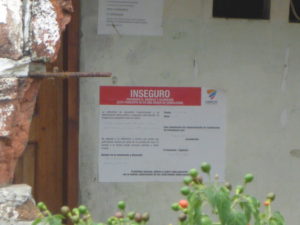
It seems so long ago now, just over a week since we returned, and so much has happened between that I can barely remember that evening although I do recall we sat in the bar, our cases tucked behind us and as the light faded I very much wanted to see a fishermen, working the shoreline around the club with his net, just to see that such a basic means of survival had not been ripped from them.
The delicious meal of salmon ceviche with chips and truffle oil mayonnaise and lashings of white wine we had at Heathrow the night before seemed to belong to another age but the tasty cooked supper at Puerto Amistad was very welcome.
The next morning we awoke to the sounds of the JCB bucket clanging against concrete rubble as its relentless job of breaking down and clearing went on. I put the kettle on and went for my usual 360 degree look around through the saloon windows “Yeah” two fishermen were flying their nets either side of the club, life goes on. A couple of ‘new’ yachts had arrived and the cruising cats had left, so the estuary was open for small boat traffic then, although they might have arrived before the quakes.
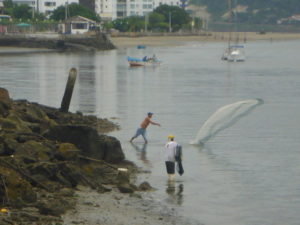
We took a walk through town to see if there was a market. A fine 70 year old building was under demolition, the lady owner who’d been born inside it almost the same number of years ago, sat in a plastic chair opposite, being comforted by kind locals.
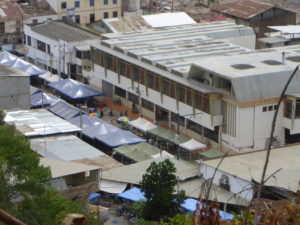
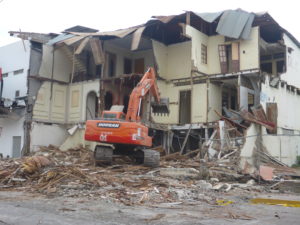
Another modern building, the upper floors mainly coloured glass, had suffered only the loss of its ground floor, single skin brick walls. The substantial concrete pillars were intact and between them and the floors above were thick pads, designed to take shockwaves, just like the bridge across the Chone, built in the same way and neither suffered terminal damage.
The modern market building needs a lot of repair work so the stall holders have moved into the street, under blue tarpaulins. We stocked up with some fresh produce and a big white slab of young cheese that can be eaten as it matures, depending on how long it lasts.
Back at the club for a beer before returning to Zoonie, new owner Gene explained the repairs he had carried out. The old fishing quay on which the club is built appears to have slipped a few centimetres towards the river and some roof repairs had to be carried out, but business was normal again in a short space of time.
The seismic activity, as it is now being referred to, was complex. First there was the big earthquake but then, as Henry from H Bar explained to me, there was a loud roar as a seismic wave raced along the malecon, (promenade) lifting everything in its wake a full metre upwards, like a hall carpet being shaken from one end sending a rippling effect along its length, and dumping it down again.
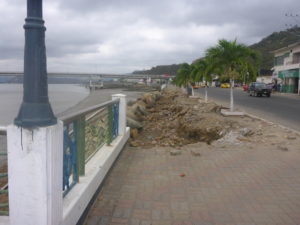
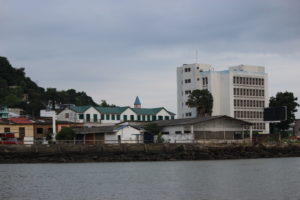
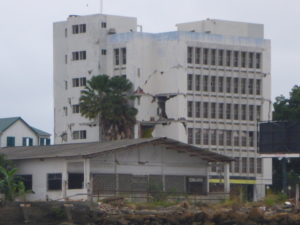
“I have been in an earthquake in California,” Henry continued, “but it was nothing like this. It was so exciting, I was sitting here and felt everything lifted high and then dropped, incredible.”
It turned from the malecon before the Hypermarket and headed towards the sandstone hills, thudding into them with unbelievable force and reverberating back into the town. “You can clearly see its path from a helicopter.” He went on.
“And what I don’t understand is I can find nothing about it on the internet, no explanation from the experts, or anything.”
“Maybe they are still trying to work it out before they write about it.” I surmised.
Toward the South Pacific
One eared dogs and feral children.
We saw the effect of the aftershock Henry in his damaged but open bar had described as we walked up the road towards the big white cross on top of the hill behind Bahia. The same hill that took the full impact of the shockwave and where most of the mortality occurred.
Small concrete homes had collapsed onto their inhabitants. Survivors clung to what was left, sleeping close by or even within their ruined homes.
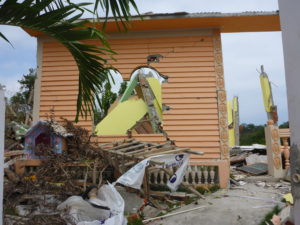
A menagerie of tents and aluminium sheds provided rooved shelters and the many dogs, mangy and mutilated from their fights, wandered out to us as we walked by. They appeared a threat only to each-other, but a few barked protectively from what was left of their territory.
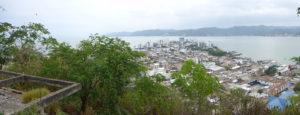

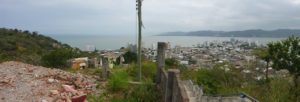
Ironically the cross, symbol of the faith of those dispossessed around it, stood intact and Rob climbed to the top for a view over the town and estuary while I passed my time with a proud one eared black and white dog and a five inch long grasshopper with a rear leg missing.
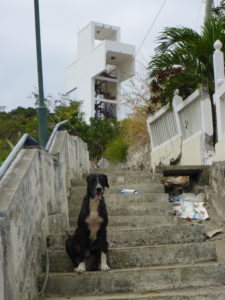
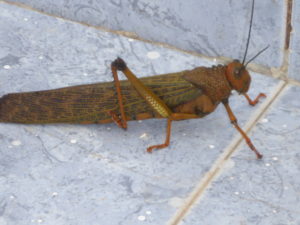
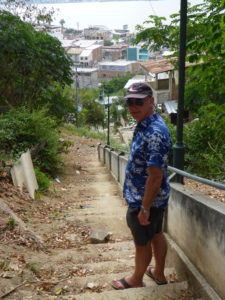
A senior school was one of the victims. It had been closed for complete refurbishment, including landscaping of the grounds, and was nearly ready for re-opening when the quake hit. The other schools had functioned in shifts, an early one, afternoon and evening shifts so no education time was lost. Our Australian friend, Suzie, who has lived here for 16 years, said she couldn’t understand why children were going through town at eleven o’clock at night wearing their uniforms. Those were the older children learning on the late shift.
Now with four schools demolished the children are running free on their idle days and whether they return to school in July will depend upon whether removable classrooms can be erected on the cleared school sites in time.
Education is free but children must be in uniform, which is an expense too far for many families at present. So when Suzie suggested giving a few families $20 vouchers to buy uniforms and supplies, each voucher would kit out a child, we happily agreed to help with the finance.
Similarly bamboo has been proven to be a durable and flexible material. Lorry loads are arriving to be used in building and as scaffolding poles. A free workshop has been set up to teach locals how to build homes with it, even although it has not yet been approved as a building material by the authorities. Suzie’s home was built of bamboo and survived the quakes unscathed.
The Ecuadorian government is giving each affected family $4000 to start their rebuilding work. The fact there are so many young families with children means Bahia has a promising future and that is good.
Back on board we had our own little developing crisis. Every now and then a little bug would land on us. Wingless and about 4mm long we wondered where they were coming from. New Zealand is very sensitive about bugs on boats, understandably so, and I had read about a rhinoceros beetle, which they absolutely ban and I was worried that we had them on board.
When the intermittent Wi-Fi at the club was once again working we Googled the dreaded beetle and fortunately ours don’t resemble the big bruisers with a rhino horn at their head end. So what were ours?
In our stowing of food for the crossing we were going through the pasta and spaghetti bags we have stored in a net in the aft cabin. Holding one bag I noticed holes in the pasta and a lot of fine dust, and then a mass of the bugs in the bag. Ripping it open while holding it overboard a cloud of dark brown bugs flew out into the river water. Another bag of the same make pasta had the same residents and went the same way. A close inspection of the rice showed no signs so I decided to call it the pasta bug.
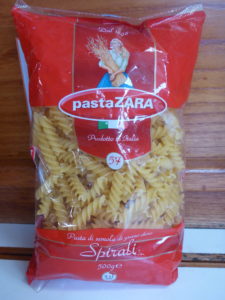
We are still finding the odd ones on board, and this morning I was alarmed to see a couple migrating towards the food cupboard in the galley. At this rate we could be pleading with the New Zealand Authorities to fumigate us!
